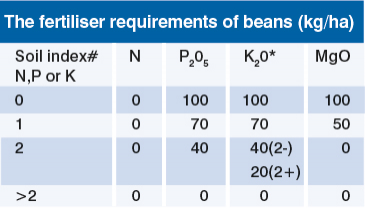 Full
FullGuide »
To reduce the risk of a build-up of persistent soil-borne diseases such as foot rots caused by Fusarium solani, Fusarium culmorum and Didymella pinodella, field beans and broad beans should be grown in no more than one year in five on the same field. There is limited information on whether the same pathogen strains can infect other legume crops. Recent cover crop work has shown that winter vetches and Berseem clover do not increase the risk of foot rot infection when grown as cover crops preceding vining peas.
Published reports suggest that pathogen strains might be host plant specific, but not enough information is available to advise whether peas and green beans can be grown in closer rotation with field or broad beans. As a precaution, it is recommended to leave five years between beans, green beans and peas.
Beans do not require a fine seedbed and will tolerate slightly cloddy conditions (although weed control may be poor) and over-cultivation should be avoided. However, beans are large seeded and require adequate moisture to germinate, so good seed to soil contact is essential. Beans are sensitive to soil compaction, but are more tolerant of consolidation and waterlogging than peas.
The requirements of beans are small and no N is required.
Where P and K fertiliser is required, it is essential to put it deep enough into the seedbed to allow full utilisation by the crop. Broadcast fertiliser should be ploughed shallow or applied over the furrows. It can then be worked in by subsequent cultivations, but the production of too fine a tilth and compaction must be avoided.
The amounts of phosphate and potash are appropriate to bean yields of 3.5 t/ha. Where yields are likely to be greater or smaller, phosphate and potash applications should be adjusted accordingly.

KEY
# According to soil analysis on the ADAS classification: 0 = very low, 1 = low, 2 = medium, >2 = high
* Not more than 50 kg/ha K20 should be combine-drilled, otherwise germination may be affected. The rest should be broadcast